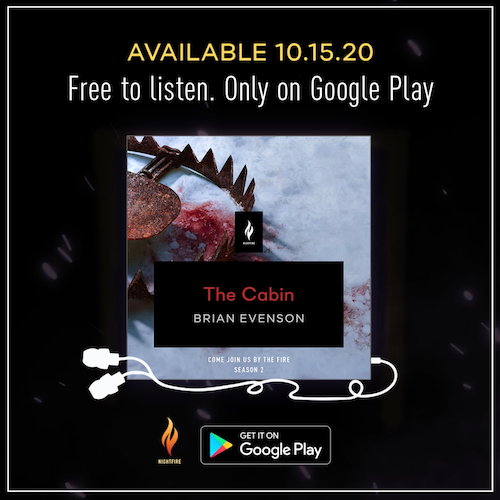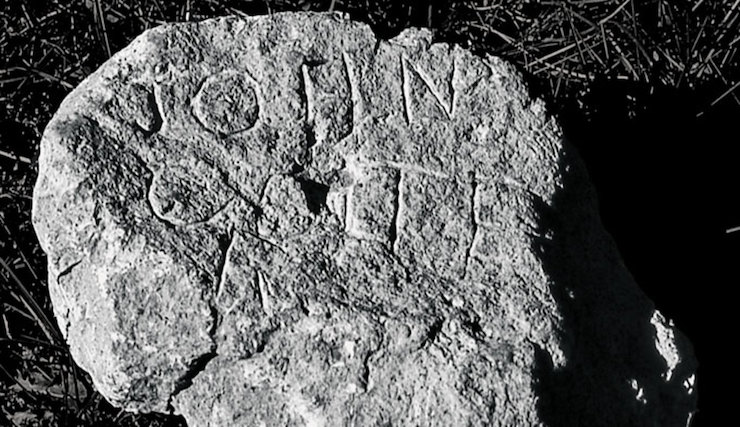To celebrate the release of the second season of Come Join Us By The Fire, our audio horror anthology, we’ve asked authors with stories included in this year’s anthology to join us and write about horror. Below, Brian Evenson, whose story “The Cabin” you can listen to here, writes about how a mysterious piece of American ephemera spun itself into a short story.
blank text
blank text
On Writing “The Cabin”
In 1933, in Tetonia, Idaho, a tiny town a little less than an hour away from the slightly larger tiny town of Ucon that my wife grew up in, a man with the unlikely name of William Beard, while clearing a field, dug up a rock. The rock was of rhyolite lava and was carved vaguely in the shape of a man’s head. It wasn’t big. It was around the same width and height as the piece of typing paper that I am writing the first draft of this account on, and only about four inches thick. The name “John Colter” had been carved on the right side of the stone. A date, 1808, was on the other.
Some people think the stone is a hoax, something, I suppose, that Beard buried so he could trade it for a pair of boots (which is what he exchanged the stone for). Others see it as proof that John Colter, one of the first (and perhaps the very first) mountain men, was the first European to cross through Yellowstone and see the Grand Tetons on the other side. There are historians on both sides of the issue, with slightly more favoring the idea that the stone is real, but nobody seems certain.
When I first heard about it, what interested me more about the stone, the question that kept nagging me, was Why was the stone carved in the shape of a head? I understand the desire to mark your passage through your time on earth. I remember when I was growing up in Utah all the places on the cliff faces and exposed rock where people had carved their initials and the dates when they had passed through, some of them going back to the time of the pioneers—and some petroglyphs even going back hundred and even thousands of years. Or the tree trunks with hearts hacked into them with two sets of initials nestled inside, commemorating the eternal love of an unknown couple who had either broken up decades before or who had stayed together but were either quite old or dead. But I couldn’t remember ever seeing, or even hearing about, a stone that had been deliberately shaped into a head and then had someone’s name and a date carved on it. That seemed more appropriate to me as a memorial, a grave marker. It seemed like the kind of thing you would make as a substitute for a person because they are no longer alive.

Those speculations are where my story “The Cabin” began, and slowly other things began to stick to them. That’s how stories often build for me, little moments or incidents that I find myself catching hold of that make me imagine other, darker, fantastical possibilities, which slowly build into a strange and mysterious web.
In John Colter’s case there was plenty more to be curious about, a lot else that was mysterious and allowed for my imagination to run wild. Even the spelling of his name is uncertain, appearing variously as Colter, Coalter, and Coulter. And there was also the fact that nobody knows for sure when he was born—sometime between 1770 and 1775. In addition, nobody is quite sure when he died: one account reports May 7, 1812, of jaundice, another November 22, 1813, of causes unknown, when he somewhere between the age of 36 and 43.
I began to imagine a life between one of Colter’s deaths and the other, imagined that he might have died, then gone through a kind of strange hellish purgatory, then died again. Then I began to imagine Colter tethered to his own stone, then to consider who or what might have done the tethering, and why, and that led me to think of other people similarly tethered, and a creature, who appeared human, who had begun to collect them by collecting their stones. I began to think about the way in which some places seem like they could potentially open up onto another world, how you can (or at least I can) walk through a stretch of wilderness and then, when you return, not recognize it, feel like it has, in the meantime, become some other, less genial place. I thought about my upbringing in Utah, the winter hikes and snowshoeing I had done, and the one time, at scout camp during the winter, near midnight, when I had set out to walk across a frozen lake (since it would take me back to my snow hut quicker). I had gotten about halfway across and started to feel the slosh of water around my feet, which scared the hell out of me. The other boy I was with said we shouldn’t worry, that it was a sunny day and so of course the snow on top of the ice had melted. We pressed on, my heart beating furiously. Only when we were soaked halfway to the knees and both seriously worried about falling through and I was incapable of taking another step forward, did we finally turn back.
Very little of this made it into the story itself. Colter is far from the central character, and only appears briefly. But the spirit of all those speculations is still part of the story, and are what the story came from. A former student of mine, Rose Andersen, wrote an excellent memoir about the death of her sister called The Heart and Other Monsters. In it, she speaks about the act of writing about her sister as being like “writing around the edges of her ghost.” I felt like what I was doing was writing around the edges of that real Colter stone, in a way that revealed imagined stones. And an imagined collector of stones. And a vicious imagined dilemma. And an almost-too-modern cabin that beckoned through the darkness to those who were lost and in distress. A cabin that served not as a refuge, but as a trap.
Brian Evenson is the recipient of three O. Henry Prizes and has been a finalist for the Edgar Award, the Shirley Jackson Award, and the World Fantasy Award. He is also the winner of the International Horror Guild Award and the American Library Association’s award for Best Horror Novel, and his work has been named in Time Out New York’s top books. His most recent collection is Song for the Unraveling of the World.
Listen to Brian’s story “The Cabin” on Google Play here, and listen the the entirety of the second season of Come Join Us By The Fire here.



